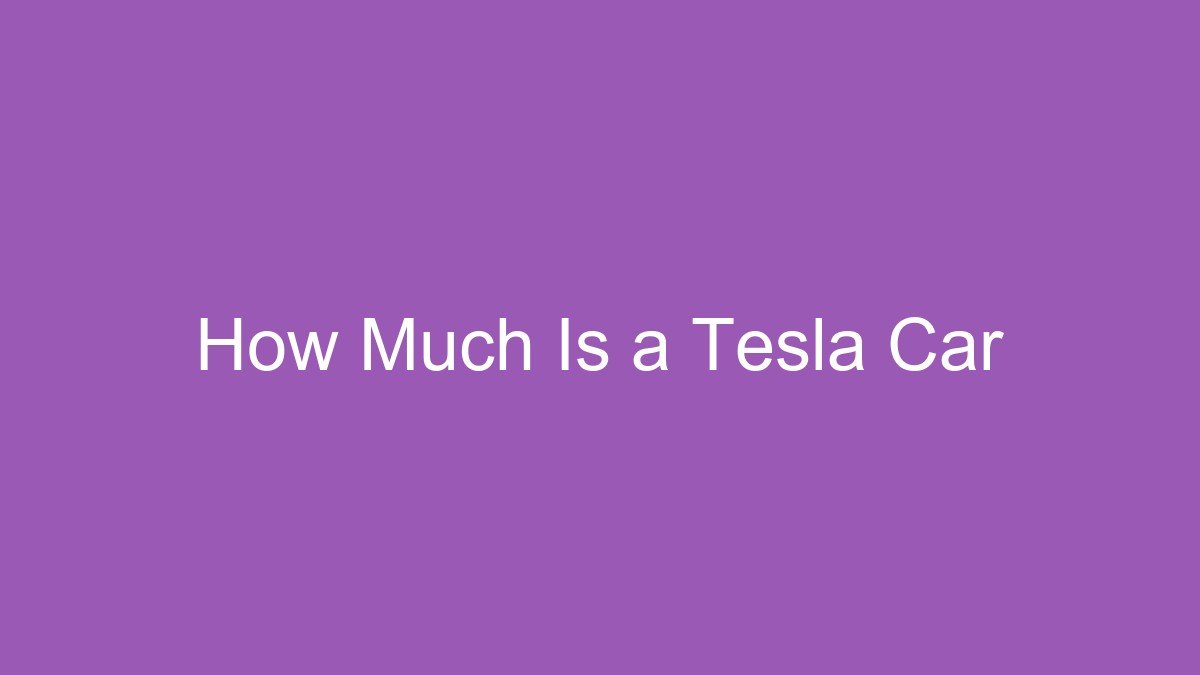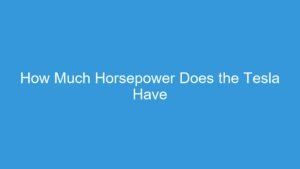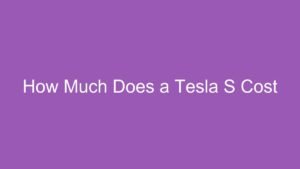
Contents
- How Much Is a Tesla Car? Your Ultimate Guide to Understanding Tesla Pricing
- 🛒 Recommended Product
- The Big Picture: What Influences a Tesla’s Price?
- Step-by-Step: How to Figure Out Your Tesla Price
- 🛒 Recommended Product
- Current Tesla Models and Their Starting Price Ranges (Estimates)
- Smart Buying Tips for Your Tesla Purchase
- Common Mistakes to Avoid When Buying a Tesla
- Conclusion: Your Tesla Awaits!
- 🛒 Recommended Product
- FAQ
How Much Is a Tesla Car? Your Ultimate Guide to Understanding Tesla Pricing
Dreaming of owning a Tesla and wondering about the investment? You’re not alone! Tesla cars are synonymous with innovation, performance, and sustainability, making them a top choice for many. However, the question, “How much is a Tesla car?” isn’t a simple one with a single answer.
The price of a Tesla can vary significantly based on the model, trim level, optional features, and even your location. But don’t worry, we’re here to help you navigate the exciting world of Tesla pricing. This detailed guide will break down all the factors, offer step-by-step instructions for finding your price, provide helpful tips, and point out common mistakes to avoid.
Let’s demystify Tesla costs together!
🛒 Recommended Product
The Big Picture: What Influences a Tesla’s Price?
Before we dive into specific models, it’s crucial to understand the main components that contribute to a Tesla’s final price tag. Think of it like building a custom home – the base structure is just the beginning!
-
The Tesla Model: This is the most significant factor. Tesla offers a range of vehicles, from the more accessible Model 3 and Model Y to the premium Model S and Model X, and the revolutionary Cybertruck. Each model has a different starting price reflecting its size, performance capabilities, and luxury features.
-
Trim Level/Battery Range: Within each model, you’ll often find different trim levels, typically impacting battery range and performance. For example, a “Long Range” variant will generally cost more than a standard range, and a “Performance” variant will be the highest tier. Higher range and faster acceleration typically mean a higher price.
-
Optional Upgrades & Customizations: This is where you can truly personalize your Tesla, but each choice adds to the cost:
- Paint Color: While a basic color is usually included, premium metallic or unique colors come at an extra charge.
- Wheel Size & Design: Larger or more aerodynamic wheels can be an optional upgrade.
- Interior Configuration: Different interior colors or materials might be available at a premium.
- Software Enhancements: This is a big one! Features like Enhanced Autopilot or Full Self-Driving (FSD) Capability are significant software upgrades that dramatically increase the price. They are often sold as optional add-ons or subscription services.
-
Taxes, Fees, and Destination Charges: Just like any new car purchase, you’ll need to account for:
- Sales Tax: Varies by state and locality.
- Destination Fee: A non-negotiable fee charged by Tesla for transporting the vehicle from the factory to the delivery center.
- Documentation Fee: A fee for processing paperwork.
- Registration & Licensing Fees: Required by your state’s DMV.
-
Potential Incentives & Credits: This is where you might save money!
- Federal Tax Credits: The U.S. government often offers tax credits for purchasing eligible new electric vehicles. These credits can significantly reduce your effective purchase price, but eligibility criteria (vehicle price, battery origin, income limits) can change.
- State & Local Incentives: Many states, cities, and utility companies offer their own rebates, tax credits, or other perks (like HOV lane access) for EV owners.
-
Financing vs. Cash: While not directly part of the car’s sticker price, your payment method impacts the total money you spend. Financing (taking out a loan) will incur interest charges over time.
Step-by-Step: How to Figure Out Your Tesla Price
Ready to get a more concrete number? Follow these steps using Tesla’s incredibly user-friendly online configurator (which is the best tool for this!):
-
Step 1: Choose Your Model.
- Visit the official Tesla website (tesla.com).
- Click on “Order Now” or navigate to the “Vehicles” section.
- Select the Tesla model that best fits your needs and budget (e.g., Model 3, Model Y, Model S, Model X, Cybertruck). This is your starting point.
-
Step 2: Select Your Trim Level.
🛒 Recommended Product
- Once you’ve chosen a model, you’ll typically see different options like “Rear-Wheel Drive,” “Long Range,” or “Performance.”
- Click through these options. Watch the price update in real-time as you select different battery ranges and performance levels.
-
Step 3: Customize Your Exterior & Interior.
- Paint Color: Choose your desired exterior color. Notice how the price changes for premium options.
- Wheels: Select your preferred wheel design and size.
- Interior: Pick your interior color scheme.
- Tip: Stick with the standard options if you’re trying to keep the cost down!
-
Step 4: Consider Software Upgrades.
- You’ll see options for Enhanced Autopilot and Full Self-Driving (FSD) Capability. These are powerful driver-assist features.
- Understand that FSD is a significant investment. Decide if these advanced features are essential for you right away, or if you prefer to subscribe later or rely on the standard Autopilot included with every Tesla.
-
Step 5: Account for Charging Solutions (Optional but Important).
- While not part of the car’s sticker price, consider the cost of installing a Wall Connector at home if you want the fastest charging speeds. This can be an additional few hundred to over a thousand dollars for the unit and installation by an electrician.
-
Step 6: Don’t Forget Taxes & Fees.
- On the Tesla configurator, look for an “Estimated Delivery” or “Purchase Price” breakdown. This will typically include the destination fee.
- To estimate sales tax and registration, you’ll need to know your local rates. Tesla’s final order agreement will provide a detailed breakdown of all mandatory fees.
-
Step 7: Look for Potential Incentives.
- This step isn’t on the Tesla website directly, but it’s crucial for your out-of-pocket cost.
- Research federal EV tax credits (check IRS.gov or fueleconomy.gov for current eligibility rules).
- Search for state and local EV incentives in your area. Websites like the Department of Energy’s Alternative Fuels Data Center (AFDC) are great resources.
- Subtract any potential incentives from your estimated price to get a clearer picture of your net cost.
-
Step 8: Get Your Final Estimated Price.
- The Tesla configurator will display a “Purchase Price” or “Est. Price” based on your selections, including the destination fee.
- Add your estimated sales tax, registration, and any home charging installation costs.
- Subtract any eligible federal, state, or local incentives.
Current Tesla Models and Their Starting Price Ranges (Estimates)
Please remember that Tesla prices are highly dynamic and can change frequently due to market conditions, supply chain issues, and new features. The prices below are approximate starting ranges for new vehicles, before options, taxes, or incentives (as of early 2024, for the US market):
- Tesla Model 3: Generally ranges from ~$39,000 to ~$55,000+
- Known for: Its accessibility, performance, and compact executive sedan feel.
- Tesla Model Y: Generally ranges from ~$44,000 to ~$65,000+
- Known for: Its SUV versatility, impressive range, and optional third-row seating.
- Tesla Model S: Generally ranges from ~$75,000 to ~$90,000+
- Known for: Its luxury, blistering performance, and long-range capabilities.
- Tesla Model X: Generally ranges from ~$80,000 to ~$100,000+
- Known for: Its unique Falcon Wing doors, SUV practicality, and high-tech features.
- Tesla Cybertruck: Generally ranges from ~$60,000 to ~$100,000+
- Known for: Its futuristic design, extreme durability, and powerful utility (currently in early production, prices more variable).
Always use the official Tesla website configurator for the most up-to-date and accurate pricing for your specific build.
Smart Buying Tips for Your Tesla Purchase
- Define Your Needs First: Before you even look at prices, consider what you truly need. Do you require maximum range, thrilling performance, or just reliable daily commuting? Your answers will guide you to the right model and trim, potentially saving you thousands.
- Utilize the Online Configurator Extensively: This is your best friend for understanding costs. Play around with different options to see how they impact the total price.
- Factor in the Total Cost of Ownership: Beyond the purchase price, consider:
- Electricity Costs: Charging at home is significantly cheaper than gasoline.
- Insurance: Tesla insurance premiums can sometimes be higher due to the advanced technology and repair costs. Get quotes before buying.
- Maintenance: EVs generally have lower maintenance costs than gasoline cars due to fewer moving parts.
- Stay Informed About Incentives: Government incentives can change frequently. Do your homework right up to the point of purchase to ensure you qualify for any available tax credits or rebates.
- Consider Financing vs. Leasing: Understand the pros and cons of each. Leasing typically means lower monthly payments but no ownership, while financing leads to eventual ownership but potentially higher monthly costs.
- Don’t Forget About Home Charging: Plan for how you’ll charge your Tesla. A NEMA 14-50 outlet or a dedicated Wall Connector offers the best home charging experience. Factor in the installation cost.
- Test Drive: While not directly about price, a test drive is crucial to confirm your decision and ensure the chosen model meets your driving preferences.
Common Mistakes to Avoid When Buying a Tesla
- Forgetting About Taxes and Fees: Many buyers only look at the base price on the configurator and forget to factor in significant sales tax, destination fees, and registration costs. These can add thousands to the final bill.
- Underestimating Charging Costs/Infrastructure: Assuming you’ll only use Superchargers (which can be more expensive than home charging) or not planning for a home charging solution can lead to unexpected costs or inconvenience.
- Not Understanding Software Upgrades (FSD): Jumping straight to the most expensive FSD option without fully understanding its current capabilities or whether you truly need it. FSD is a significant investment; evaluate if it’s right for you.
- Ignoring Insurance Implications: Some buyers are surprised by the cost of insuring a Tesla. Always get insurance quotes before finalizing your purchase to avoid sticker shock.
- Missing Out on Incentives: Failing to research and apply for eligible federal, state, or local EV incentives can mean leaving thousands of dollars on the table.
- Impulse Buying Without Research: While Teslas are exciting, making such a significant purchase without thorough research into different models, trims, and total ownership costs can lead to buyer’s remorse.
Conclusion: Your Tesla Awaits!
Determining “How much is a Tesla car?” is a personalized journey, but with this guide, you’re well-equipped to navigate it. Remember, the online configurator on Tesla’s official website is your ultimate tool for building your dream car and getting an accurate, real-time price estimate.
🛒 Recommended Product
By understanding the factors that influence cost, following our step-by-step process, leveraging smart buying tips, and avoiding common pitfalls, you’ll be well on your way to confidently understanding the investment in your new Tesla. Happy configuring, and enjoy the ride into the future of electric driving!
FAQ
Q. What is the starting price range for a new Tesla car?
A. The starting price for a new Tesla car typically ranges from approximately $38,000 to over $100,000, depending heavily on the model chosen. The most affordable models usually begin in the high-$30,000s to low-$40,000s, while performance and larger models can easily exceed $80,000 before options.
Q. What factors primarily influence the final price of a Tesla?
A. The final price of a Tesla is influenced by several key factors: the model (e.g., Model 3, Model Y, Model S, Model X, Cybertruck), the trim level (e.g., Rear-Wheel Drive, Long Range, Performance), chosen battery size and motor configuration, additional features like “Full Self-Driving” (FSD) capability, premium interior upgrades, wheel choices, exterior paint color, and any destination or documentation fees.
Q. Which Tesla model is the most affordable, and how much does it typically cost?
A. The most affordable Tesla model is typically the Model 3, specifically the Rear-Wheel Drive (RWD) variant. Its starting price generally hovers around $38,000 to $40,000, although this can fluctuate due to market conditions, incentives, and Tesla’s pricing strategy.
Q. What is the approximate cost of the highest-end Tesla model currently available?
A. The highest-end Tesla models are usually the Model S Plaid and Model X Plaid. Their starting prices often begin around $85,000 to $95,000 and can easily climb well over $110,000 or $120,000 with additional options, premium features, and “Full Self-Driving” capability.
Q. Do government incentives or tax credits reduce the actual cost of a Tesla?
A. Yes, government incentives and tax credits can significantly reduce the effective cost of a Tesla, depending on the buyer’s location and eligibility. The U.S. federal EV tax credit, for example, can offer up to $7,500 for qualifying new electric vehicles that meet specific battery sourcing and manufacturing requirements. Many states and local governments also offer their own rebates or incentives, so it’s essential to check current programs.
Q. How much do optional features like “Full Self-Driving” (FSD) or enhanced Autopilot add to the price?
A. Optional software features like “Full Self-Driving” (FSD) capability can add a substantial amount to a Tesla’s price. FSD is currently priced at $12,000 (as of late 2023/early 2024, subject to change) if purchased outright, or it can be subscribed to monthly. The “Enhanced Autopilot” package, when available as a separate option, typically costs around $6,000. These are significant add-ons to the base vehicle price.
Q. Does the price of a Tesla include charging infrastructure or installation?
A. No, the price of a Tesla car typically does not include the cost of installing home charging infrastructure. While every Tesla comes with a Mobile Connector that allows for slow charging via standard household outlets, most owners opt for a faster Wall Connector installation. The Wall Connector itself costs a few hundred dollars, and professional installation by an electrician can range from several hundred to over a thousand dollars, depending on the complexity of the electrical work required.
Related Articles
How Much Is a Corvette
How Much Does a Corvette Cost? Your Ultimate Guide to Unlocking the Dream Ah, the Corvette. Just uttering the name conjures images of sleek lines, exh…
How Much Is a Grand Wagoneer
How Much Is a Grand Wagoneer? Your Complete Guide to Understanding the Price Tag The Grand Wagoneer. Just the name conjures images of luxurious comfor…
How Much Is a Mclaren 720s
How Much Is a McLaren 720S? Your Ultimate Guide to Understanding the Price Tag The McLaren 720S. Just the name conjures images of blistering speed, ae…
Affiliate Disclosure: As an Amazon Associate, I earn from qualifying purchases made through links on this site.















